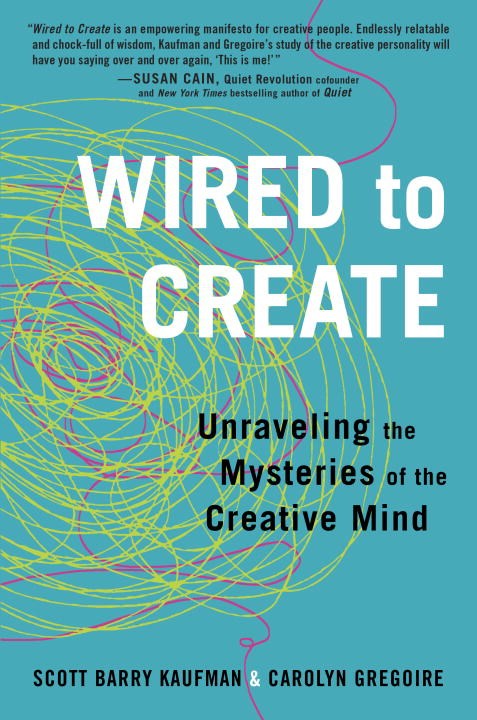Wired to Create: Unraveling the Mysteries of the Creative Mind
January 14, 2016
Scott Barry Kaufman and Carolyn Gregoire's new book coincided serendipitously with the death of David Bowie.

Wired to Create: Unraveling the Mysteries of the Creative Mind by Scott Barry Kaufman & Carolyn Gregoire; Perigee, 288 pages, $26.95, Hardcover, December 2015, ISBN 9780399174100
It seems only fitting that I open a review of a new book on creativity with a reference to David Bowie. Since the announcement of his death, it’s been impossible to wade through the internet without bumping into innumerable tributes to Bowie’s influence on music—as well as fashion and art. Two themes seem to pop up in most of these articles: Bowie as creative genius, and Bowie as weirdo (in the best possible sense, though back in the 70s his weirdness was not so universally celebrated).
I’m pretty sure Scott Barry Kaufman and Carolyn Gregoire could have featured David Bowie on the cover of their new book, Wired to Create: Unraveling the Mysteries of the Creative Mind, and applied much of their science and theory to Bowie’s career, with illuminating results. Bowie simply embodies the kind of creative person the authors take pains to illustrate. Wired to Create goes to great lengths—scientifically, historically, and anecdotally—to explain how creative people think (complexly and paradoxically), why there is not just one sort of creative person, and then present insight into the many myths of creativity. To me, it seems Bowie was all and none of them.
First off, Kaufman and Gregoire make one thing very clear: “Creative people have messy minds.” Their academic research, based on scientific studies, shows that the popular left-brain/right brain dichotomy is false. Not only is the whole brain involved in creativity, but creativity is not even “a single characteristic but a system of characteristics.” Each person has a different mix of these characteristics, which ensures individuality and open accessibility to creative pursuits. For example, the authors refer to a study that indicates, surprisingly, that while creative people do have some characteristics in common with the mentally ill, those same people are often more “grounded and self-aware.” We tend to think of “the artist” mythically—preternaturally driven to create at the expense of all else, often starving, tortured as a result—but it’s not that simple in reality. People are complex. Creativity is complex. And, as a result, all people have access to creativity in their own manner. We may not transport ourselve to the stars as Ziggy Stardust, but if we understand how the creative mind works, we can better understand how we too can act out our internal imaginings.
One of the most fascinating things about creative work is that it brings together and harmonizes these conflicting elements, which exist to some extent in everyone.
So how do people find their own personal recipe, or characteristic concoction, for creativity? One way, the authors argue, is through play. Whether it is through encouraging imaginative play during childhood, or carrying that way of thinking into adulthood and ensuring that play remains a part of lives, “cultivating a childlike sense of play can revolutionize the way we work.”
If we look at David Bowie again, I think it’s quite obvious that—while he certainly went through dark periods of addiction, struggles with relationships, and knee-jerk criticism when branching out into a variety of musical genres—he wholeheartedly invested in play. He was lauded for his sense of humor and kindnesses. And all of those qualities were apparent in his costuming and his tinkering, his experimentation and innovation. Being playful as an adult is an oft-dormant opportunity for each of us, even if we are applying our opened mind to company innovation or personal development goals..
This false dichotomy we’ve set up between play, on the one hand, and work, on the other, is not only illusory but also destructive. Research shows that hybrid forms of work and play may actually provide the most optimal context for learning and creativity …
Kaufman and Gregoire aren’t simply interested in encouraging the making of art, or the advantages of creative problem solving; they endeavor to show how creativity is an essential part of being human. “In embracing a creative way of living,” the tell us, “we bloom into the expansiveness of our own being and our beautiful human complexity.” They dig deep into the psychology of their topic telling us how hope plays a part in the creative personality because rejection is so prevalent, how trauma often creates fertile ground for creative ideas, and how nonconformity stimulates originality in the face of disapproval.
Steeped in both that psychology and the latest developments in neuroscience, and clearly and warmly written, Kaufman and Gregoire have created an essential primer on the creative. While there are many great books on the topic that I’d recommend that serve specific aspects of creativity, Wired to Create succeeds in providing context, research, and stimulus for anyone looking to better understand how weird, and wonderful creative minds—like David Bowie's, and like your own—work.

